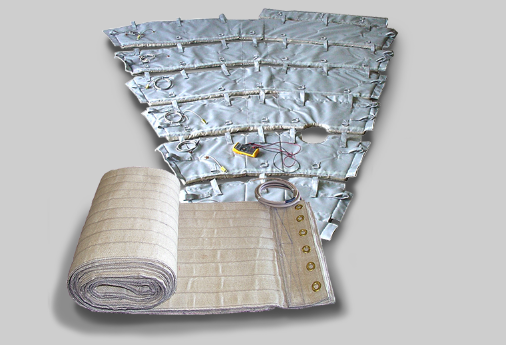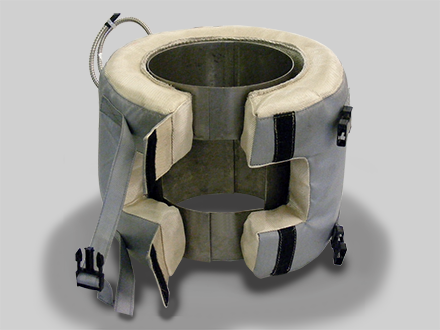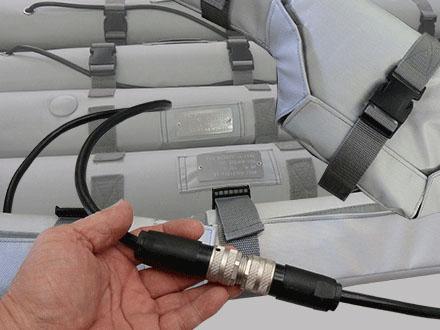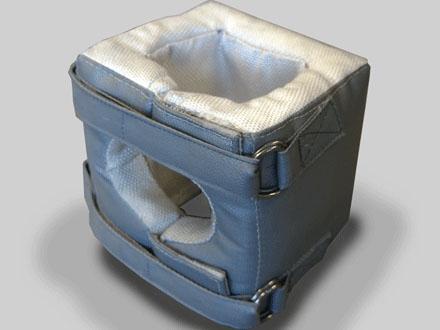ABOUT JACKETS & BLANKETS
Heating jackets and insulator jackets work to maintain the temperature of an object or fluid by trapping heat inside. The insulation prevents heat from escaping the system, and it can save energy or require less power to achieve and maintain an ideal temperature.
Heating jackets use a heating element to maintain the correct temperature. This configuration can use a multi-stranded tape-type heating element or a self-regulating cable-type element to achieve the desired temperatures to ensure that gases or fluids stay at the proper temperature. Insulator jackets, unlike heating jackets, do not use a heating element to control the temperature. Instead, the insulation itself works to maintain the temperature of whatever object or fluid the jacket surrounds.
Manufacturers, industrial plants and laboratories often need to keep a range of fluids and gases at consistent temperatures, such as water, asphalt, hydrocarbons and plastics. Heating jackets safely regulate temperatures inside plumbing or other duct work without affecting surrounding systems. Typical heating jackets and insulator jackets are available in cylindrical or flat shapes, and are perfect for heating or insulating round pipes or large, flat expanses.
Many industries and laboratories often require specially shaped pieces of plumbing, equipment and machinery that must maintain a certain temperature, as well. Our team can design a custom-built sleeve that can cover the object, fitting around irregularly sized and shaped elements and allowing the regulation of internal temperatures. Sleeved jackets for uneven surfaces are available as a thermal heating sleeve or as an insulator jacket only.
If you need a heating blanket, insulator jacket or custom-designed heating sleeve, or if you have any questions about any of our products, contact any of the experts at HTS/Amptek® today by calling 281-340-9800.
Frequently Asked Questions
Temperature control mechanisms are recommended for all types of heating tapes. We provide temperature controls with heating tape systems to make one cohesive network, and we utilize existing controls. There are a variety of control mechanisms available and the best choice depends on the temperature, voltage, accuracy and output used in your system. A mechanical bulb and capillary thermostat are recommended for temperatures below 325 degrees F. For voltage control a variable transformer or solid-state Triac controller may be used. For precise temperature control you can activate from a bench-top or wall-mount, we recommend the BT-15 or WM-15. We supply a complete list of thermostats and similar mechanisms, and we are happy to help you select the ideal device for your needs.
Can I Leave the Unused Portion Rolled Up?
No, your heating tape will not function properly if it is not touching the heat sink from end to end. Rolled up heating tape can be hazardous, so be sure your heating tape is completely and properly installed.
How Can I Tell Which Side is "Up"?
Heating tape exhibits a uniform temperature on both sides. Either side of the heating tape may be applied to the heat sink.
Can I Cut Heat Tape?
No. Heating tapes utilize constant electric flow throughout and are designed for a fixed resistance at a given length and voltage. The tape is pre-designed to suit your environment and attempting to modify it will destroy the tape.
How Does Heat Tape Work?
Heating tapes utilize a constant watt density at a fixed resistance over a fixed length and voltage to create heat. Heat output is based on a given input voltage. Heat transference to pipes, floors and other surfaces occurs through direct contact with the tape. An insulator surrounding the enclosed heating element stops the heat from escaping and maintains a desired temperature. Temperature controls integrated into the circuit allow you to control the temperature.
Why Is Heat Tape Temperature Different in Some Places?
The materials inside the heating tape determine the operating temperature. Different heating tapes utilize different materials to create and maintain a desired temperature.
Can I Hook Heat Tape Up to a Thermostat?
Heating tapes effectively integrate with a wide variety of temperature control devices such as: thermostats, variable transformers, Triacs, solid-state digital temperature controls, programmable logic controllers (PLC's) or computers.
Why do I need different sized heat tape?
The size of your heating tape is determined by a variety of factors, including a proper mechanical fit, heat output, voltage and temperature rating, among others. Expert installers at HTS/Amptek® Company will help you select the correct heating tape size for your application to ensure optimal energy efficiency, safety and durability.
What heat tape sizes can I choose from?
HTS/Amptek® Company supplies a range of heating tape sizes to give you the best fit. Our heating tape sizes are available on our price list and online store. When choosing your heating tape, be sure to consider the heat output, voltage and temperature rating involved in your application. If you are not sure which size is best for you, contact us and we are happy to assist you.










